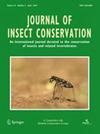Long droughts decrease tiger- and ground-beetle’ beta diversity and community body size in savannas of the Gorongosa National Park (Mozambique)
IF 1.9
3区 农林科学
Q2 ENTOMOLOGY
引用次数: 0
Abstract
Abstract We assessed the Caraboidea communities of Gorongosa National Park (GNP) in Mozambique. Influence of tropical rainfall, after a long period of drought, was evaluated on alpha and beta diversity of tiger- and ground-beetles in the main habitat types of the park: miombo forests, mixed forests, transitional forests, and grasslands (open savannas). Tiger- and ground-beetle communities were sampled by pitfall traps set up in 25 sites of each habitat type along three sampling periods, comprising the transition of dry season to the wet season. After the first rainfall, an increase in alpha diversity was observed across GNP habitats, particularly in grasslands. Higher values of beta diversity were observed between the dry and wet sampling periods, particularly in grasslands. In contrast, community dissimilarities between sampling periods were not significant in the transitional forests. Community body size in grasslands increased after the rainfall, partly due to the occurrence of caraboid species that were exclusive of forest habitats during drought. Transitional forests, as ecotone habitat areas, appeared to support grassland species during drought, serving also as a source of forest species that may colonize the open areas in the wet season. Forest species will probably be more threatened by climate aridification and future landscape changes due to climate change.长期干旱减少了戈龙戈萨国家公园(莫桑比克)稀树草原上老虎和地甲虫的β多样性和群落规模。
摘要/ Abstract摘要:对莫桑比克戈龙戈萨国家公园(GNP)的巨角兽群落进行了评价。在长时间的干旱后,评价了热带降雨对公园主要生境类型(miombo林、混交林、过渡林和草原(开放稀树草原))虎甲虫和地甲虫α和β多样性的影响。在各生境类型的25个地点设置陷阱,沿旱季向雨季过渡的3个采样期对虎甲虫和地甲虫群落进行采样。在第一次降雨后,在国民生产总值生境中观察到α多样性的增加,特别是在草原上。干取样期和湿取样期的β多样性值较高,特别是在草地上。不同采样期的群落差异不显著。降雨后草原群落体大小增大,部分原因是干旱期间森林生境所特有的角蛾类的出现。过渡带森林,作为过渡带的栖息地,在干旱期间似乎支持草原物种,也作为森林物种的来源,可能在雨季殖民开放地区。由于气候变化,森林物种可能更容易受到气候干旱化和未来景观变化的威胁。
本文章由计算机程序翻译,如有差异,请以英文原文为准。
求助全文
约1分钟内获得全文
求助全文
来源期刊
CiteScore
3.60
自引率
10.50%
发文量
76
审稿时长
6 months
期刊介绍:
The Journal of Insect Conservation is an international journal devoted to the publication of articles concerned with the conservation of insects and related invertebrates. The Journal of Insect Conservation publishes papers on all aspects of conservation and biodiversity related to the insects and closely related groups such as Arachnids and Myriapods, including ecological work which has conservation implications. Research papers may address the subject at the community, population or species level, may cover aspects of behaviour, taxonomy or genetics, be theoretical or practical, and be local or global in nature. Review articles are welcome as well as points of view which are likely to stimulate debate. From time to time the journal will publish Special Issues on specific subject areas which are the focus of current research. Proposals for such issues are welcome.

 求助内容:
求助内容: 应助结果提醒方式:
应助结果提醒方式:


